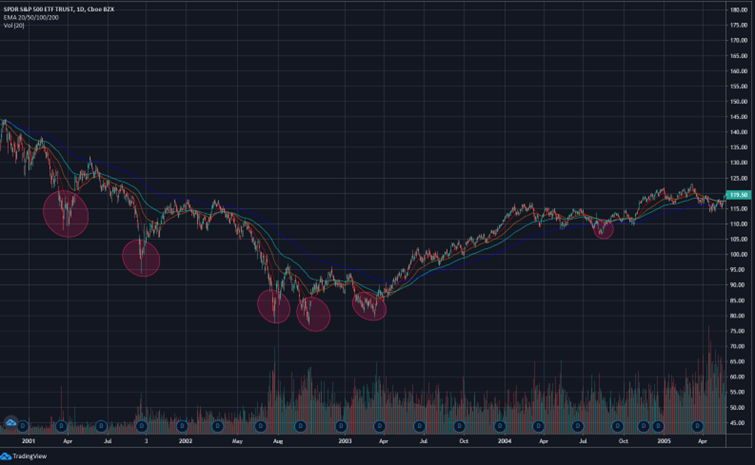What does buy the dip mean?
Buying the dip follows the basic investment principle of “buy low, sell high” but with a slightly more targeted approach. There are two prerequisites for buying the dip: a sharp decline in stock prices and a strong indication that they will rise again. One of the most common examples of this is when a large company’s share price suddenly drops due to broad market fears, rather than concerns about the company’s long-term performance.
Just one example: Before the COVID-19 market, Johnson & Johnson’s share price crashed what was then a record high on February 5. On March 23, 2020, the share price of eight companies was down 28%. By April 20, 2020, the company had virtually erased all losses. Investors who bought Johnson & Johnson shares in late March bought the dip.
To be clear, no one knows when the bottom will come, and trying to time the market is never a good idea. But there are plenty of opportunities to invest in shares or stock market indices during downturns if you are ready to invest for the long term – and you know where to look. When you find them, you can trade CFDs and get a high leverage that allows you to earn more than from trading shares.
How to buy the dip?
Look at the sectors most affected by the sell-off. Broad Market Index, which tracks a diverse stock market index such as S&P 500, is a proven way to invest. But the same strategy can also be applied to the 11 sectors that make up an index like the S&P 500.
Looking at sectors with the biggest declines in stock prices and then analyzing the funds or indices that track that sector can highlight some opportunities to buy the dip.
Below are the four stock market sectors that saw the biggest declines so far during the COVID-19 crash (April 20, 2020).
Energy. The S&P 500 energy sector dropped almost 45 percent, marking the most steep decline. Within this sector, the energy equipment and services industry recorded the largest losses, down 61%.
Economy. The financial sector also fell sharply, dropping over 28%. This was driven by large declines in banks and consumer finance, which fell by 39% and 43% respectively.
Industry. The industrial sector consists of industries such as aerospace and defense, airlines, construction and engineering equipment, and electrical equipment. Driven by severe declines in the aerospace industry (which plunged almost 57 percent), the entire sector is down 24 percent overall.
Material. The materials sector, which includes industries such as metals and mining, containers and packaging, and chemicals, is down by 20%.
Look at big companies with big price drops
Like Johnson & Johnson, some of the country’s largest companies have been able to recover quickly from the coronavirus downturn. In fact, Microsoft’s and Amazon’s share prices have been rising from year to year – for these companies, the downturn is over, at least for now.
However, some blue-chip companies that have otherwise been stable for years were hit hard by the global pandemic, and their valuations have yet to recover. Looking for cases like those could provide an opportunity to buy into large companies at the lowest prices in years.
However, this strategy comes with a caveat: we do not recommend investing in individual stocks. Experts usually find that low-cost index funds are the best choice for most investors. Index funds are less risky than individual stocks and provide diversification to your portfolio through a single investment.
Major differences between CFD and stock trading
The main difference between CFD trading and share trading is that with CFDs you do not take ownership of the underlying share. You only speculate on its price movements, making it a more flexible trading option. CFDs give you an opportunity to profit from the upward or downward movement of the asset.
Another key difference between taking a long position with a CFD and buying a security is the ability to make leveraged trades. CFDs are traded on margin, which means that a trader can open larger positions in relation to the amount of initial capital they have.
By exploring the benefits of CFD trading compared to share trading, you may find that both types offer different ways to profit from price movements in the financial markets and both can make a part of your portfolio. Take a closer look at the table below and decide which one works best for you now.
| Contracts for difference (CFDs) | Stock trading |
| Trade CFDs with leverage to gain greater exposure with your initial capital | Pay the full value of your trade |
| CFDs allow you to open a long or short position so you can profit from rising and falling markets | When you buy shares, you can only profit from rising prices |
| Trade a variety of financial instruments between shares, indices, commodities, currencies and cryptocurrencies. | Trade only in shares |
| Trade all the time on a variety of markets | Trade only during exchange trading hours |
| No shareholder privileges | Few shareholder privileges |
Use the average method
If you have an investment account, consider making steady investments at regular intervals rather than a one-off contribution timed when you think is best. Through this strategy, known as dollar-cost averaging, you continue to buy shares throughout the dip. We look at this in more detail below.
Whatever strategy you choose, understand that buying off the dip does not guarantee getting in at rock bottom prices. In volatile markets, today’s floor can become tomorrow’s top. All that means is that the company’s valuations are significantly lower than they were a few months or weeks ago, giving investors an opportunity to buy in at the relatively low price.
If you believe that stock prices will eventually rise to or beyond previous highs, buying at today’s lower prices may be a good strategy for generating long-term returns – you may just need to make a few big drops before you realize them.
Does it always work?
Yes, yes, “past performance is no guarantee of future results”. But here’s a strategy that has worked pretty well so far throughout the ongoing 21st century: Buy the dip. “Stonks always goes up”. In fact, they have done so.
For this post, I will go through the daily SPY chart from January 1, 2001 to now and use these rules to buy and never sell: I have about $100,000 to spend during that entire time. I know this is a sum that many people will never have, but for me and probably most people reading this, not really something impossible to save over 20 years. I buy for $1000 at a time, as I envision living through this period and money has to be made first for us to invest, we don’t make smaller purchases as the fees would go over 1 percent of our trades this way, 1 percent I consider acceptable I only buy when the market is down (below the EMA 200) and there is a significant increase in volume
I always buy at the closing price
 I have highlighted all the dips that I definitely want to go into. I’m not going to pretend I’m an expert who always knows when to buy, never FOMOing and always has diamond hands. I won’t. I’m going to turn this into a Python script that just spits out buy dates that I can’t argue with. Fortunately, I know an indicator – Exponential Moving Average that is perfect for this kind of thing. I also notice that volume tends to increase on panic days. If you look closely, there is already a problem with this strategy starting to show itself. There is hardly any “dip area” in 2003-2004. I would sit on a pile of cash in real life and miss the rise. Could I really? Prominent buys circled on that chart: – March 16, 2001 – red day, huge volume spike. 115, get 8.7 shares of SPY. – September 19, 2001 – $102 and 9.8. – July 19, 2002 – smooth sailing for a while, getting 11.9 shares for our standard purchase. The algorithm spit out 163 buying opportunities, so we would only have to put over $614 each purchase instead of $1000 to reach our allocation. Assuming we would sell near the top (hypothetically, we never get greedy and have no unexpected expenses), we would have roughly 2.5 times our money in 20 years. Kind of overwhelming, no? Inflation in the US between 2001 and today has been 47.79 percent And that’s like apples in the supermarket, not houses or stocks.
I have highlighted all the dips that I definitely want to go into. I’m not going to pretend I’m an expert who always knows when to buy, never FOMOing and always has diamond hands. I won’t. I’m going to turn this into a Python script that just spits out buy dates that I can’t argue with. Fortunately, I know an indicator – Exponential Moving Average that is perfect for this kind of thing. I also notice that volume tends to increase on panic days. If you look closely, there is already a problem with this strategy starting to show itself. There is hardly any “dip area” in 2003-2004. I would sit on a pile of cash in real life and miss the rise. Could I really? Prominent buys circled on that chart: – March 16, 2001 – red day, huge volume spike. 115, get 8.7 shares of SPY. – September 19, 2001 – $102 and 9.8. – July 19, 2002 – smooth sailing for a while, getting 11.9 shares for our standard purchase. The algorithm spit out 163 buying opportunities, so we would only have to put over $614 each purchase instead of $1000 to reach our allocation. Assuming we would sell near the top (hypothetically, we never get greedy and have no unexpected expenses), we would have roughly 2.5 times our money in 20 years. Kind of overwhelming, no? Inflation in the US between 2001 and today has been 47.79 percent And that’s like apples in the supermarket, not houses or stocks.
What about weekly purchases?
Say we would have access to a SPY buy app for zero commission since 2001 and we would only buy for $100 every Wednesday? Roughly 2.25x, just buying every Wednesday and never bothering means we end up with 710-715 shares of SPY compared to 800 with our super-wise dip buying (That’s a big enough difference if you manage a pension fund with 5 million people, negligible if you’re a regular investor.
About the Vikingen
With Vikingen’s signals, you have a good chance of finding the winners and selling in time. There are many securities. With Vikingen’s autopilots or tables, you can sort out the most interesting ETFs, stocks, options, warrants, funds, and so on. Vikingen is one of Sweden’s oldest equity research programs.
Click here to see what Vikingen offers: Detailed comparison – Stock market program for those who want to get even richer (vikingen.se)













